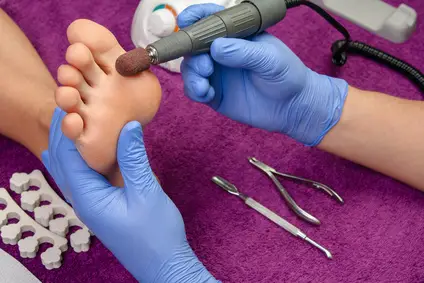You recently found something on the bottom of your foot. You found it because it started to hurt to walk on it, so you checked it out and found something growing on the underside of your foot.
Obviously, this isn’t an ideal situation, so, making the smart play, you searched online and found out it’s either a plantar wart or a callus. But how do you know which it is, and how do you treat it once you’ve identified what it is? Read on to find out the verdict between plantar wart vs callus.
Plantar Wart vs Callus
A plantar wart, otherwise known as a verruca, is caused by a virus that works its way into the weak or damaged skin and attacks the area around it, causing thickened skin and blister-like area.
Warts are found to be contagious and can spread from person to person, or even from different areas of your body. While warts can resolve themselves, because they can be contagious, it’s far better to deal with the issue before this can happen.
A callus is thickened skin that forms as a result of repeated friction or excessive pressure on the bottom and side of your foot.
Calluses can hurt, or they can be completely inert, in which case it’s just a pad of hard skin. Caused by repeated friction, it’s your body’s way of dealing with something repeatedly running against it, and the callus is the way of protecting your body against the damage.
Plantar Callus vs Plantar Wart: Differences and How to Identify
- Warts can have black dots in the center, one or many.
- Warts are usually painful if squeezed
- Calluses found in areas that either bear weight or sit on the outside of the foot
- Warts enlarge over time and can start popping up elsewhere
- Warts can bleed if trimmed back. Calluses don’t
- Warts found mostly in children and teens while calluses are more common in older people
- Calluses have skin lines following the pattern of your own body. Warts will break the lines of your skin
It can sometimes be difficult to identify whether you have a wart or a callus. If you still can’t work out whether you’ve got a callus or a wart, then the next best move is going to the doctor. They may be able to identify it for you, or failing that they will take a biopsy and send it off for analysis before suggesting a course of treatment.
Foot Callus Removal
Calluses are pads of hard skin. Before dealing with them, it helps to soften them out, whether by taking a long hot bath, or covering them with moisturizing cream and leaving it to soak in.
Once the callus is soft, it’s time to trim it back.
The easiest way to do this files it away. You can use a pumice stone, a foot file, or even a powered micro Pedi foot machine. You can start slow and work on it over time. If it starts to hurt in any area, that means that you’ve worked through the callus and you’re filing away healthy skin underneath.
You don’t have to file away the whole callus in one go. It’s fine to file it back slowly over the course of days.
Caused by pressure or friction, even if you remove the callus unless you deal with the cause, it will come back. If in doubt, see a podiatrist and have them take a look at your feet.
Plantar Wart Removal
The simplest and the easiest way of dealing with a plantar wart is to go to your doctor, who will freeze the wart out with liquid nitrogen, laser it off, or give you immune system boosters to help your body kill it.
You can also try over the counter medication, which works around half the time. If this fails, you will have to go to the doctor or just wait for the issue to resolve itself.
A common home remedy is to duct tape over the area, replacing it every few days and filing the wart back in between. However, we’ve seen no evidence that this works better than simply soaking and filing it back, which we wouldn’t recommend.
Hopefully, now you’ve been able to identify whether you’ve got a plantar wart or just a simple callus. Whichever you have, you should have the tools to deal with it, but remember, if it causes you pain or you can’t handle it yourself, you can always resolve the problem quickly and efficiently by seeing your doctor.
If you’ve ever struggled with either of these conditions, and you’ve got any stories about treatments that worked for you, or even home treatments, then let us know in the comments. Your experiences can help other people deal with the same problem, so feel free to share the difference between plantar wart vs callus!

